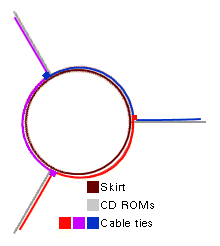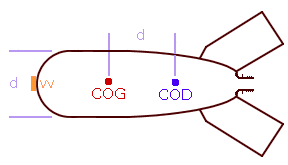The single bottle rockets based upon the standard 2 litre bottle tend to have a very short 'burn' time - more of a bang that a whoosh. I decided to have a go at joining two bottles together to make a four litre combined bottle. Following a discussion on the mailing list, (see water rocket index for details), where there are essentially two methods of joining two bottles: slice and splice; and, use a fitting, I decided to have a go at joining them using a fitting (maybe have a go at the other method later on). Based on the Robinson Coupling, it uses materials that I could find in the UK (again, at my local hardware store - see the The Copper Tube Launcher page for details). It regularly flies higher than I care to estimate (times of over 8 seconds without a parachute) but lands heavily (next project is a parachute). Nose This part is the same as on the 1½ litre 'Egglofter' page so if you have read that and familiarised yourself with it, do what is says and then skip onto the next section Coupling. To modify the bottom of a pop bottle to make it more aerodynamic, you need to have the connector described on the connector page. Attach this to the bottle (as described on that page) and pump the rocket to between 1 and 3 BarG. Unscrew the pump, leaving the hose (with its one-way
valve) in place and start to rotate the At this amount of pressure, there is little danger of a catastrophic failure of the bottle during this process as the place where it is most likely to fail is where it is hottest and thinest. When it does fail like this, it is with a Pfffff and not a bang. (you can always use the straight sides for fins - see lower down this page).
It is made from a 8mm straight central heating screw connector and, with various rubber rings and sealant, forms a sealed joint between the two bottles with the washers adding strength where required..
The hole is made in the bottom of the lower bottle with a soldering iron (I used my 15 Watt Antex Model C soldering iron with a 3mm bit), carefully cutting around until the fitting fits. Being made of brass, it tends to set the plastic and if you have put it in the hole with a little less than adequate clearance, you may find that you have to unscrew it to get it out. It is possible to cut the hole with a drill although I would not recommend this because the use of a drill may cause small fractures to appear in the bottle bottom and also, the hole left by the drill has rough sides. When you have finished, go around the hole with the soldering iron (do this anyway if you have drilled it out as smoothing it out will reduce the possibility of surface cracks), smooting as you go. Let it cool down. Next, you have the fun job of getting the inside nut onto the fitting. This can be done by putting it on a rod that is long enough or using a piece of string (I used a chopstick). It is helpful to put a piece of blutack or sealant on the bottom of the nut that will come into contact with the inside of the bottom of the bottle as this will tend t hold it still while you turn the fitting. Using this method, it can be screwed on quite tight. Once the fitting is in place, fit the skirt (measure the length so that any parts that are less han the full diameter of the bottles are covered by the skirt) and then pressure test the whole thing by filling it up completely with water and looking for any leaks. Simply tightening up the screw threads should solve any problems.
So as to try something different out each time (a fair amount of the fun comes from experiemtnation and finding out what works), this rocket has fins made from CD ROMs. When I built this rocket, the kids hadn't drank enough pop to let me have the plastic that I required for the normal fins (see the section on the 1½ litre 'Egglofter' rocket page for how to make fins from the sides of pop bottles) so I decided to have a go with the junk mail CD ROMS that many of us get from time to time - this is recycling at its best. CD ROMS curtesy of AOL (two plus another experimental one) and Compuserve (one) {Is this free adversising for ISPs or is it a demographic analysis of who sends what through the post?}.
Fixing the fins Fix a short skirt onto the bottom of the rocket so that it protrudes just a little further than the end of the nozzle. Tape it and put some tape along the edge of the skirt so that you will not cut yourself on it in the field. Through each of the fins, Tighten up the cable ties until they just hold onto the skirt on the rocket. Put gaffer tape onto the cable ties so as to hold them in place and then run gaffer tape down the join between the fins and the skirt. Cut the ends of the cable ties so that they don't go over the edge of the CD ROMs and then tape these to each other so that the cable tie ends hold the fins at the right angle. Finally, put down some extra straps of tape around the fins to stablalise them.
This bit is the same as in the 1½ litre 'Egglofter' rocket so, apart from the fact that this rocket requries 20 pence (70 grammes) in the nose, you can fix the weight in place and then skip onto the next part - Water. Ideally, you want the thing to fly straight as any deviation from this will reduce the rocket's performance. Once the thrust phase of the flight is out of the way, the rocket is essentially in free fall (even though the first part of this free fall is upwards). For it to maintain its attitude in the air, there are a few things that you will need to consider: the positions of the effective centre of drag (COD) and the centre of gravity (COG). With a small rocket such as a water rocket, it is fairly easy to find out where they are but you also need to know what to do with them. First, how to find them. To find the COG, try to balance the rocket on its side so that you find a point that is reasonably stable. The COG is above this, on the axis of the rocket as in the diagram. (If it is not on the axis, you have a problem). To find the COD, cut out a piece of cardboard the same shape as your rocket as viewed from the side and find its centre of gravity (it need not be the same size as the real rocket as long as it is to scale and that you remember to scale it back when you have found it). The centre of gravity of the cardboard model corresponds to the centre of drag. Once you have put your fins on (which you should have done before you started trying to find the COD), the COD is going to remain almost in the same position, no matter what you are going to do with the rocket (within reason) wheras the COG may be moved by adding weight to the rocket. Ideally, the rocket should weigh as little as possible so you want to add only the barest minimum of extra weight.
To move the COG forwards, make a mark with a pen on the rocket where the COG needs to be and then tape coins to the front of the rocket (at point w). Once you have found out how many you need, you can make a neat job of it with tape (or glue) so that the aerodynamic qualities that you have devoted so much of your time to are not lost. I found that for the 4 litre bottle combination that I did this to, I needed 10 x 2p pieces. (A UK 2 pence piece weighs approximately 7 grammes or ¼ ounce). This procedure is the same as in the 1½ litre 'Egglofter' rocket so, if you know what to do, do it and then you can skip onto the next part - Tests which tells you how much water you should need. We now have a water rocket that is aerodynamically sound. We know that we will be able to pump it up to a pressure of between 4 and 6 BarG (between 60 and 90 psig) and we can measure it. So, how do we know how much water to put in it? We need to know its tare weight, volume, diameter and nozzle dimensions to be able to work out how much water it will need for a flight with the greatest height. We can measure its nozzle, body diameter and weight it empty to get its tare weight but we have changed its volume so we don't know that any more - the volume of liquid it had when you bought it was not the same as its nominal volume either and in addition, there has to be a certain amount of ullage (head space) so as to take into account the expansion of the liquid when it gets hot so that the bottle doesn't burst in the shop. All we can do is measure it and the best way to do that is as follows. . . Weigh the rocket empty (you will need this for the computer model anyway). Fill it to the top with water and weigh it again. Take the former from the latter and you have your volume (close enough) as, for the purposes of water rocketry, 1 gramme equals 1 cm³. These figures were then fed into my computer model and the weights in the table below were calculated to be the optimum for the pressure range. To put them into practice, put a piece of gaffer tape along the side of the rocket and weigh in the optimum amount of water. Mark on the gaffer tape where the water comes to, screw a top on, invert it and make another mark (in such a way that you will not be confused - possibly using an arrow pointing upwards). This will make life easier when in the field and you haven't got access to the scales. If your rockets have tare weights or capacities that are different to these, you can use the above graph to work out roughly the right weight of water optimised for height - this assumes that the rocket capacity and diameter are roughly in proportion. I compared the 2 litre 'Egglofter' with this 4 litre rocket and found the results below. All of the rockets were pressure tested to around 1.3 times the normal pressure for twice the normal time of pressurisation. This was done by filling completely with water, attaching the connector described on the 250mls rocket page and pressurising. The reason for filling with water is that water is effectively incompressible and therefore can be taken up to quite high pressures without holding a dangerous amount of energy - the energy in the water rocket pressure tests is from the elastic deformation of the bottle during the test.
These computer predictions worked out to be correct as far as the times and heights were concerned. They were launched from the Copper Tube Launcher, timed and measured.
|
||||||||||||||||||||||||||||||||||||||||
|
||||||||||||||||||||||||||||||||||||||||
 bottle, holding the nose (a)
approximately 9" above a gas ring (for those
without gas rings, I have seen a barbecue mentioned as an
alternative although I have not used one myself).
After a while, the plastic will have softened
sufficiently to form a hemispherical shape by itself (b), at
which point, you should cool it down under a cold tap or
in a bowl of cold water.
bottle, holding the nose (a)
approximately 9" above a gas ring (for those
without gas rings, I have seen a barbecue mentioned as an
alternative although I have not used one myself).
After a while, the plastic will have softened
sufficiently to form a hemispherical shape by itself (b), at
which point, you should cool it down under a cold tap or
in a bowl of cold water.
 The main idea with this rocket is the
coupling between the two 2 litre bottles (see the
blow-up on the right).
The main idea with this rocket is the
coupling between the two 2 litre bottles (see the
blow-up on the right). The skirt between the
two bottles supprts the upper bottle (which only has
air in it and therefore does not weight very much and is
supported adequately even under the high acelleration of
the thrust phase). The skirt is taped to the lower
bottle but not to the upper bottle. This allows the upper
bottle to be replaced easily should this become
necessary.
The skirt between the
two bottles supprts the upper bottle (which only has
air in it and therefore does not weight very much and is
supported adequately even under the high acelleration of
the thrust phase). The skirt is taped to the lower
bottle but not to the upper bottle. This allows the upper
bottle to be replaced easily should this become
necessary. To cut a CD ROM, you
should not try the score and bend method (we tried
this and all that happened was the thing shattered -
breaking anywhere except along the score line). It
is possible to use a saw to cut along the green line on
the diagram on the left but I found that a soldering iron
did the job very well. I scored the line and then cut it,
slowly and carefully along the score line with the tip of
my 15 Watt Antex Model C soldering iron with a 3mm bit.
To cut a CD ROM, you
should not try the score and bend method (we tried
this and all that happened was the thing shattered -
breaking anywhere except along the score line). It
is possible to use a saw to cut along the green line on
the diagram on the left but I found that a soldering iron
did the job very well. I scored the line and then cut it,
slowly and carefully along the score line with the tip of
my 15 Watt Antex Model C soldering iron with a 3mm bit.  Once the 3 CD ROMs are cut,
they need a slot cutting in them (that is just big enough
to fit a cable tie) and for this, whether you used a
soldering iron to do the initial cut or not, is best done
with the soldering iron. Simply lay the CD ROMs
on top of eacf other and use the hole in the first one to
mark the rest.
Once the 3 CD ROMs are cut,
they need a slot cutting in them (that is just big enough
to fit a cable tie) and for this, whether you used a
soldering iron to do the initial cut or not, is best done
with the soldering iron. Simply lay the CD ROMs
on top of eacf other and use the hole in the first one to
mark the rest. pass a cable tie. Put the end of each cable
tie through the rachet of the next so as to form an
oversized ring with the fins threaded onto it.
pass a cable tie. Put the end of each cable
tie through the rachet of the next so as to form an
oversized ring with the fins threaded onto it. So where does the COG want to
be? The COG needs to be between 1 and 2
rocket body diameters (d) forward of the
COD - in free flight, the COG
effectively pulls the rocket forwards and the COD pulls
it back - if they are between 1 and 2 rocket body
diameters apart, they are able to exert enough of a
couple (a couple is a pair of equal and opposite
forces that do not share the same axis and therefore tend
to have a twisting effect) to correct the rocket's
attitude during flight.
So where does the COG want to
be? The COG needs to be between 1 and 2
rocket body diameters (d) forward of the
COD - in free flight, the COG
effectively pulls the rocket forwards and the COD pulls
it back - if they are between 1 and 2 rocket body
diameters apart, they are able to exert enough of a
couple (a couple is a pair of equal and opposite
forces that do not share the same axis and therefore tend
to have a twisting effect) to correct the rocket's
attitude during flight.